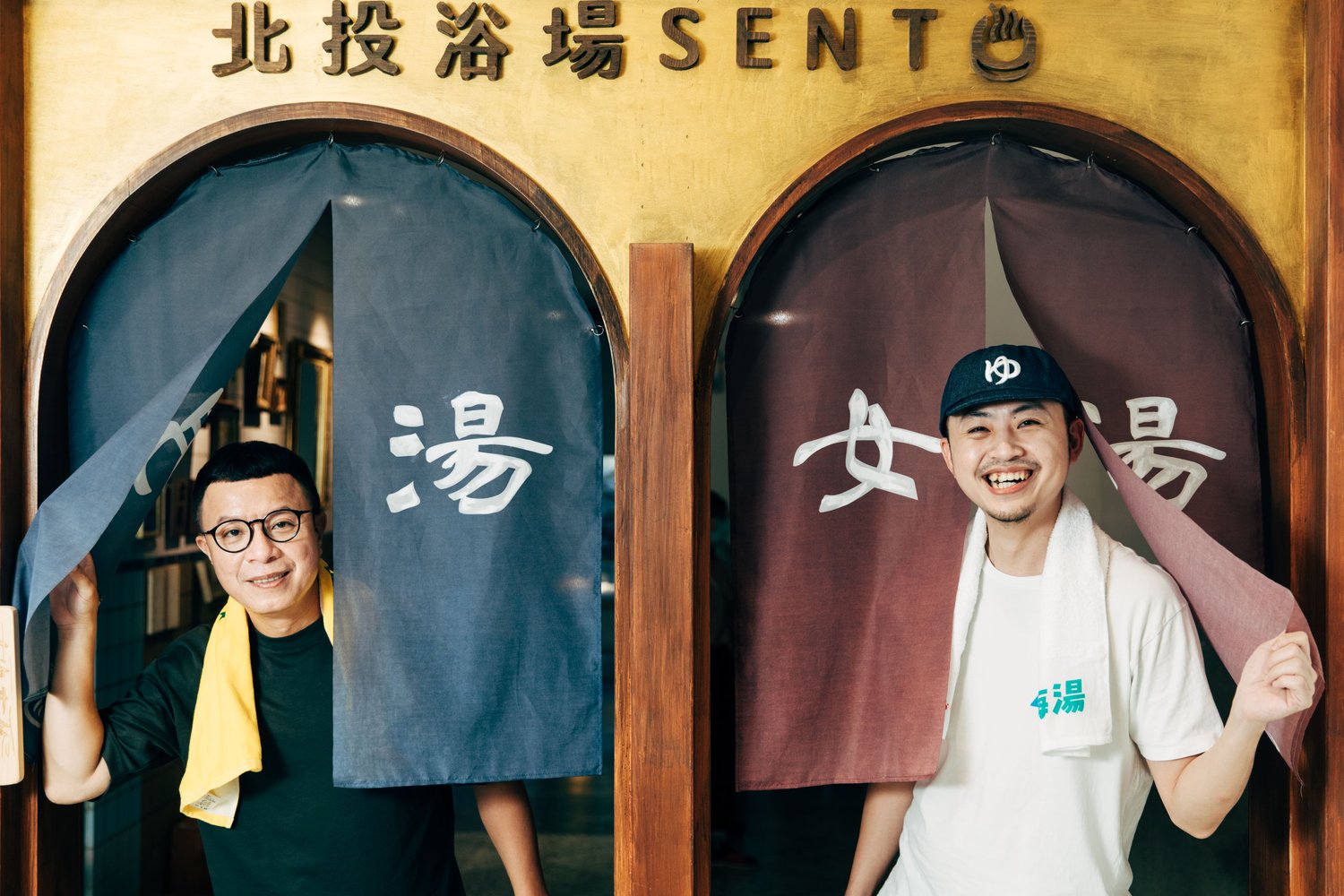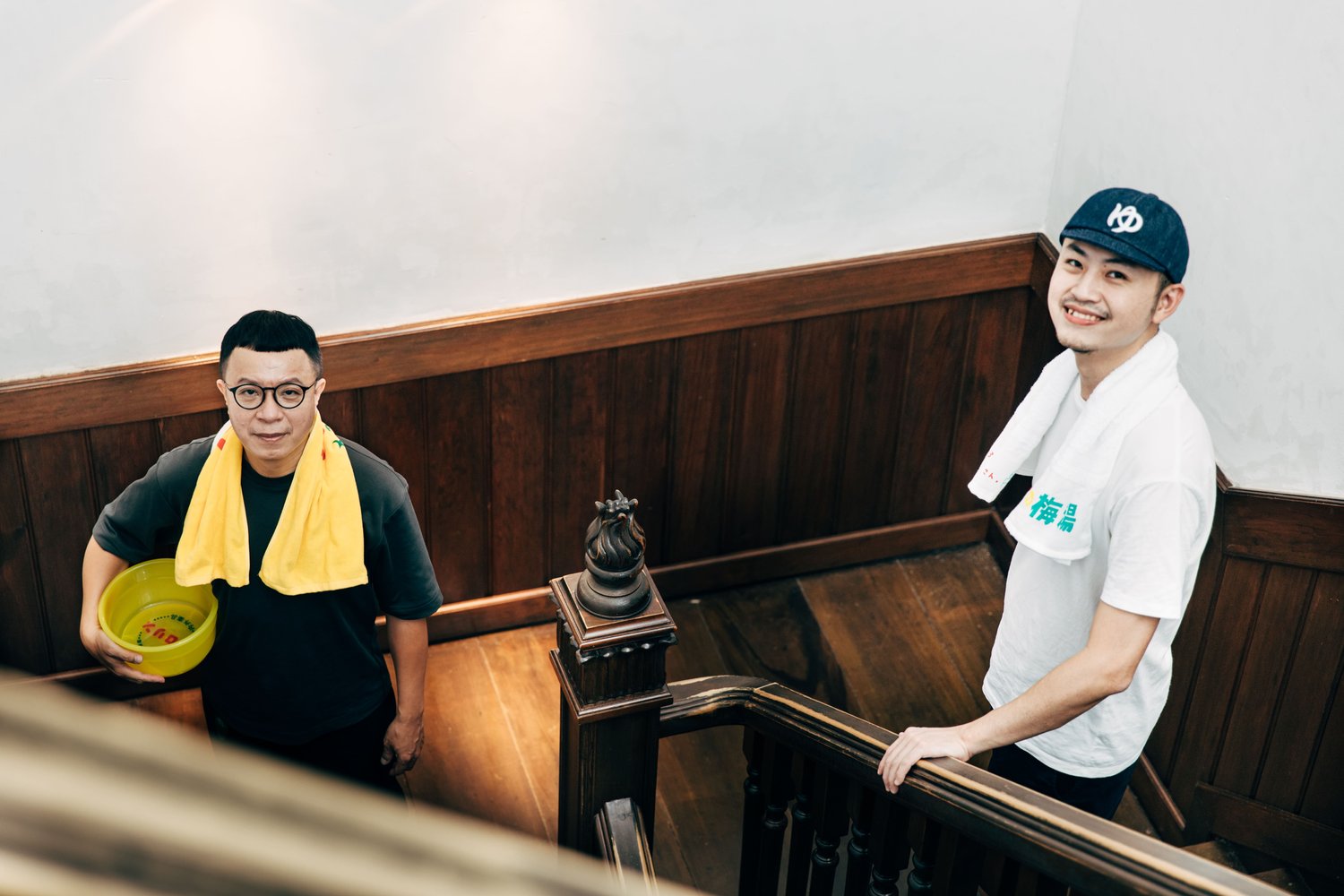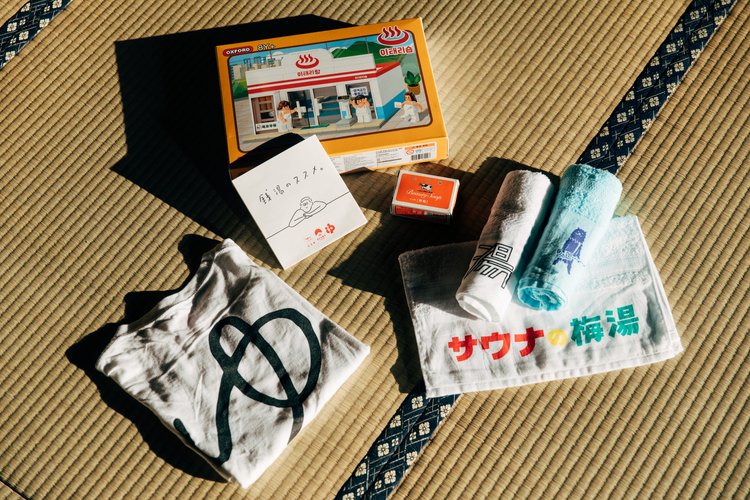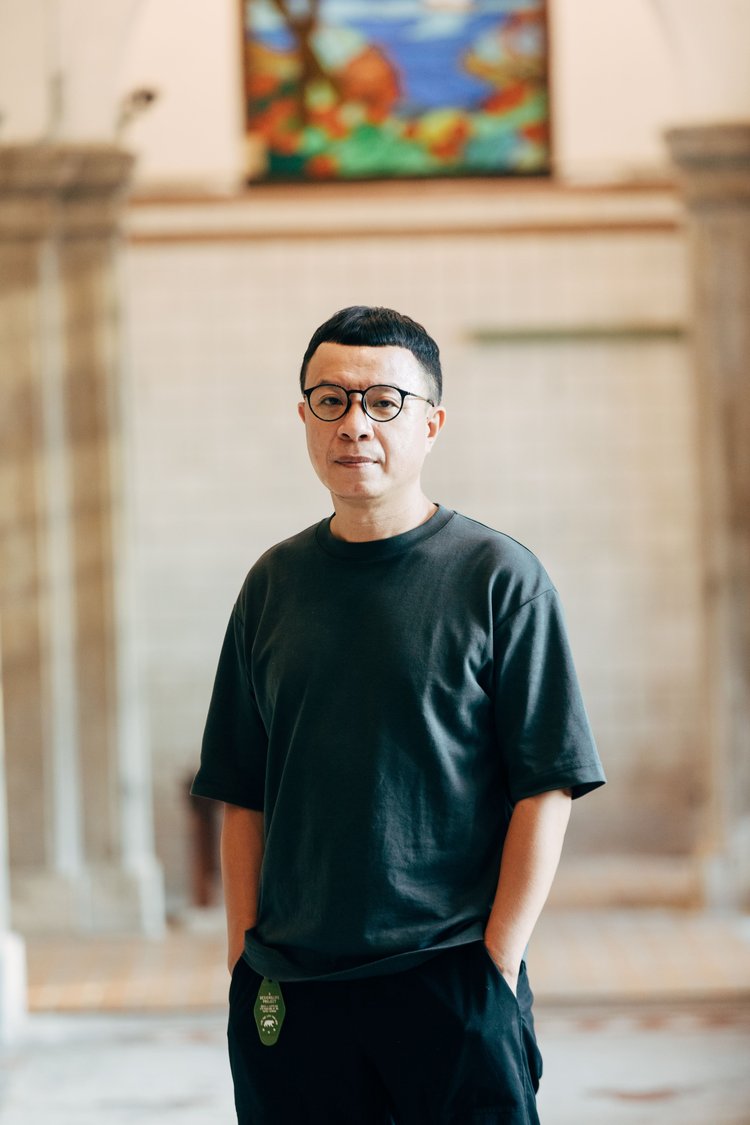We Love Sento!The Cross-generational Conversation of Sento Fans!
Designer Hally Chen & Travel writer dato
Text/ 郭慧
Dictation/ Hally Chen、dato
Photography/ 蔡耀徵
In the days before home bathing was widely available, the sento hidden in the neighborhoods was a good place for people to take a bath. However, why are people still fascinated by the charm of sento when everyone already has a bathroom in their home? To answer this great question, we invited two cross-generational sento enthusiasts - Hally Chen, the author and designer of "Long Life the Tea", and dato, travel writer and music critic - to share how they fell in love with sento!
Q:When did you first experience the Taiwanese baths and Japanese sento respectively?
Hally Chen ( abbreviated as H below): When I was in my third grade, I went to the Longquan Bathhouse in the Geothermal Valley in New Beitou with my mom for the first time. I remember that it was designed as a single room for one person, and it only cost NT$10 for one bath with a 30-minute time limit. But they would knock on the door every 15 minutes for fear that the customers would faint inside. In fact, I was living near Wuxing Elementary School, which is very far from New Beitou. But after that visit to the Longquan Bathhouse, I would usually take bus 266 to New Beitou with my brother. I would buy dried beans at the entrance of the alley and then put them in the basin, floating on the surface of the bathtub water, and enjoy them while soaking in the tub. As for the bathhouse culture of sento, it was during my trip to Kyoto that I came to love it.
dato ( abbreviated as D below): My first experience in bathing in a hot spring was when I went to Tainan with my family as a child. Later, when I went to university in Taipei, I would ride a motorcycle with my classmates from Jingmei to Yangmingshan to soak in Ma-Chu Hua-Yi Village Hot Spring to feel the sensation of being naked under nature (laughs). As for my first time visiting a hot spring in Japan, it was around 2011 or 2012 when I traveled to Kyoto to collect information for my book Sakyoto Daily Day-Off. It was a sento that looked like an ordinary private house near Kyoto University called Higashiyama-yu. Most of the bathers were college students from the neighborhood. These college students even introduced sento to us in English, which made me feel the human touch in sento. Since then, every time I travel to Japan, I always arrange a trip to sento. I even put towels and body wash in my backpack when I go out.
H: Yeah! That’s right. For those who like hot springs, it's a habit to put towels in your backpack when you travel in Japan.

The Beitou Hot Spring Museum used to be the largest "Beitou Public Bath" in East Asia. Nowadays, it is not only a popular local museum, but also a must-see for sento fans.
Q: What role does going to sento play in your life?
H: I can't remember exactly when I started going to sento, but what I can say for sure is that every trip I took to Japan afterwards was focused on three main themes: sento, curry rice, and tea stores. When I travel to Japan, I often go out early in the morning to shop, and by 3 or 4 pm, I'm already tired of walking. At this time, I would like to find a place to rest, and sento is the perfect salvation. Especially at 4:00 p.m., there are not many people in the sento, so you can enjoy the sento while everyone is still at work. There is also a feeling of excitement in your heart. The best part is that after the sento, you can walk out invigorated feeling that I am an awesome guy again! For me, sento is a very important stopover in my trips as well as a boon to travelers. To this day, my Google Map shows the location of the tea store, curry rice and sento. Here's a tip for you all. If you want to find a nearby sento, just look for the chimney because sento must have a chimney!
D: I totally agree with what Hally said! I always travel with a schedule full of places I want to visit and a backpack full of shopping trophies from various places, so by the afternoon, my shoulders are already sore. Sento is a place where you can unload your backpack and let your shoulders and neck relax. I just need to spend an hour or so in the sento, scrubbing up, and then emerge as an energetic guy again! I also like to visit a sento in the afternoon, when I can always see grandpas nearby with basins, soaps and towels, while taking a bath and chatting about daily chores, which is a very charming daily scene.

Hally Chen and dato, two cross-generational sento fans, share how they fell in love with sento at the Beitou Hot Spring Museum, which used to be the "Beitou Public Bath" a hundred years ago!
Q:What are the similarities and differences between Taiwan's hot spring culture and Japan's sento culture?
H: I would say that going to a hot spring is a pleasure when traveling, while a sento is a place where people go to take a bath day after day in their daily lives. In addition, the Japanese sento has a unique architectural style, layout and surrounding props. In traditional sento, such as Dogo Onsen and Funaoka Onsen, the building is mostly built up in a karahafu (唐破風) style (a undulating curve at the top with two sides sunken), and between the entrances is the bandai (番台), which is the place where the owner collects money. If you don't have soap or towels with you, you can buy them directly from the bandai. I usually prepare some coins for a blow-dry after bathing, and wrap up with a glass of cold milk. My favorite is the coffee flavor. This whole set of architectural style, scenes and related props constitute the Japanese sento culture. In Taiwan, soaking in a hot spring is also a popular recreation for many people, but the bathers' practices are different, unlike Japanese sento, which has a well-established ritual or process.
D: I found that bathing in a hot spring is a more touristy activity, and sento exists in people's daily life, so people can go there with slippers. In addition, as Hally said, there is a set of fixed procedure for bathing in a sento in Japan. First, you go to bandai to pay (each prefecture and city has its own price, ranging from 420 to 460 yen), and then go to the shoe locker to put your shoes, change clothes and go into the bath. After you leave the bath and blow-dry your hair, you must drink chilled milk, etc. I drink juice flavor.
Q: Would you like to share your impressive experience in visiting Sento with us?
H: Few people know that Kyoto Tower Bath House YUU is located in the basement of Kyoto Tower.
It was a wonderful surprise to me when I once visited Kyoto Tower and inadvertently walked to the second floor underground. Before you leave Kyoto, I think it's perfect to go to the Kyoto Tower Bath House YUU to take a bath as a finishing touch, or when you arrive in Kyoto in the morning and it's not time to check in at the B&B, you may want to go to the Kyoto Tower Bath House YUU to take a bath first. It' s a pity that YUU is not open due to the pandemic. As for Tokyo, Konparu-Yu, located next to the intersection of Ginza Shichimachi, is near many famous tea stores. Its location is very convenient making it probably my most frequented Tokyo sento. Konparu-Yu is a small but beautiful sento, with not much space, but everything you need inside. The koi tile paintings in the bathhouse are impressive in their own right, with irises, yuzu, and lavender floating in the bath from season to season.
D: I like Funaoka Onsen in Nishijin, Kyoto. This hot spring is a converted pavilion with a small bridge, a carp pond, baroque tiles and a wooden tengu on the roof, making the atmosphere retro and gorgeous. When I first walked in, I felt that this place was super magical, as if it was frozen in time and space. When I visited Nishijin, I usually went to Sarasa Nishijin (さらさ西陣), a café converted from a bathhouse, and then walked a few steps to Funaoka Onsen for bathing. It's a great way to spend the day in a street with a theme of sento. In addition, I also like Ume-yu in Kyoto. Ume-yu is run by a young man who aspires to revive the sento and then takes over the old sento. In addition to running the sento, it also provides various peripheral services to the community, such as selling vegetables, rice and used CDs, or organizing events at the sento. I like to go to Ume-yu in the evening, the atmosphere is very nice.

Hally Chen, author and designer of "Long Live the Tea", and dato, travel writer and music critic, talk about the dreamy sentoprops they have collected over the years.
Q: There are often many interesting sento props when bathing in sento, such as a bath bucket, tile decoration, and chilled milk. If you were asked to select one of them as the representative props of sento, which one would you choose?
H: The most representative one is the eternal bucket, the yellow plastic basin used for bathing, which is named for its durability. The bucket is made by the Japanese pharmaceutical company KERORIN. At first, they printed their ads on the basins in bath houses everywhere to market their products. Now, when you click on the official website of KERORIN, the first thing you will see is the eternal bucket.
D: I would say the most representative one is also the yellow basin. But the one I collected myself was a joint product between BEAMS JAPAN and the soap brand Buttermilk Alkaline. I bought it when I went to Kotobukiyu in Ueno, Tokyo, where BEAMS JAPAN and Cow Style jointly held a sento recommending event. During the event, the Cow Style was exclusively packaged in orange and commemorative T-shirts with the word "ゆ" written by illustrator Yu Nagaba, which symbolizes a bathhouse, were released.

Hally Chen's private collection of sento props: KERORIN eternal buckets, small chairs and stools, soap boxes, towels, and wooden keys for sento shoe cabinets.

dato's private collection of sento props: BEAMS JAPAN co-branded Cow Style, Ume-yu and other sento towels, commemorative T-shirts with the word "ゆ" written by illustrator Yu Nagaba, sento map, and the Korean version of the bath LEGO and so on.

Profile/Hally Chen Born in Taipei, Hally Chen has been engaged in art design for records for many years, and his works have been nominated for "Taiwan Golden Melody Award" and "IMA Independent Music Award". Since 2008, he has been writing columns for many magazines. He is keen to design and draw with his left hand and write with his right hand using a camera. He is the author of The Remote Icy & fruit punches shop, Coffee House of Humanity, and Long Life the Tea.

Profile/dato He is a music critic and travel writer, and a member of the creative group "Men's Day Off Committee". He currently runs the Facebook fan page "dato: POP LIFE" and hosts the podcast program "CITYBOY's User's Guide". He co-authored Sakyoto Daily Day-Off and Hokkaido Central Men's Day Off with the Men's Day Off Committee and published his own book Putting Chiang Mai in Your Pocket in 2019.
